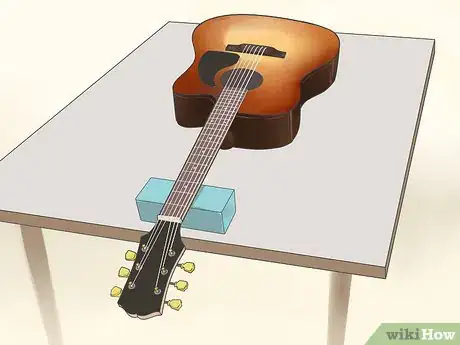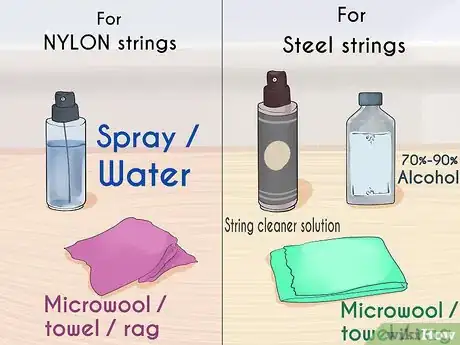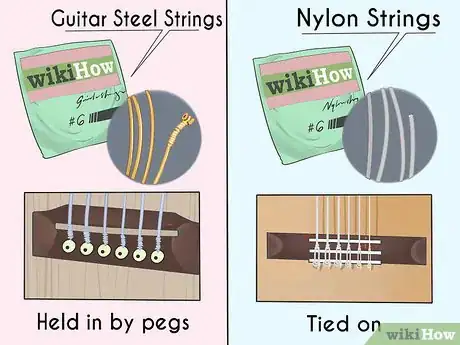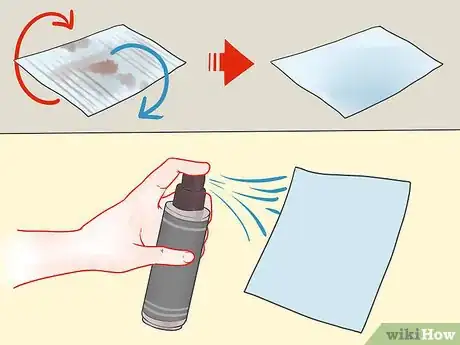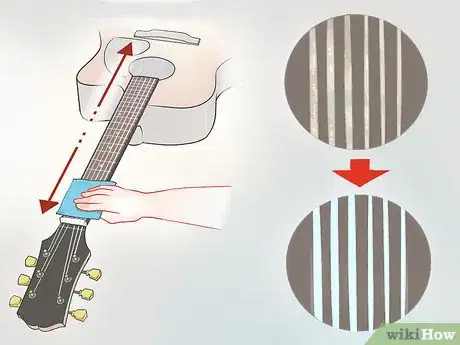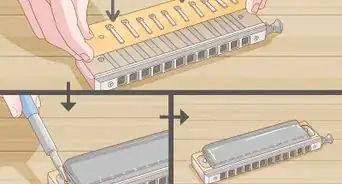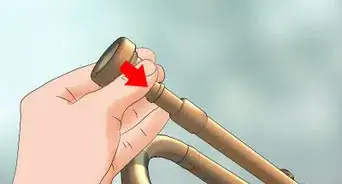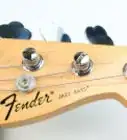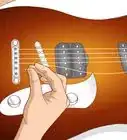This article was co-authored by Ron Bautista. Ron Bautista is a professional guitarist and guitar teacher at More Music in Santa Cruz, California and the Los Gatos School of Music in Los Gatos, California. He has played guitar for over 30 years and has taught music for over 15 years. He teaches Jazz, Rock, Fusion, Blues, Fingerpicking, and Bluegrass.
There are 8 references cited in this article, which can be found at the bottom of the page.
wikiHow marks an article as reader-approved once it receives enough positive feedback. In this case, 89% of readers who voted found the article helpful, earning it our reader-approved status.
This article has been viewed 359,384 times.
Your guitar strings are an integral part of your instrument: you can't play a thing without them. However, strings can become easily and even invisibly dirty, which can negatively impact their longevity and the quality of music you can produce. You can keep your guitar's strings in optimum condition by knowing when to clean your strings, removing grime from them, and then lubricating them.
Steps
Removing Grime from Your Strings
-
1Position your guitar. Free up your hands to do work by resting your guitar on its back. You can use a table, a box, your guitar case, even your own lap. Alternatively, if your guitar has a neck strap, wear the neck strap and turn the guitar face up. Make sure the guitar's head is not touching anything to ensure that your tuning pegs don't get messed with in the process, and ideally place it on a block to stabilize it.
-
2Select a rag and cleaning solution. Some people prefer to use a paper towel, microfiber cloth, or dry dish towel that they fold into eighths; other people prefer to use a clean cotton diaper.[1] Any number of cloth or paper products will work, you just want to make sure that it's clean, dry, and relatively soft. Instead of applying the cleaning solution directly to the strings, which will also result in your guitar being sprayed, spray the solution onto your rag first. This will prevent any excess cleaning solution from gathering and being difficult to remove.[2]
- For a guitar with nylon strings, a non-dampened towel or one slightly dampened with water will suffice.
- For guitars with steel strings, there are guitar string cleaners that are manufactured for use like Fast-Fret String Cleaner, Dunlop Ultraglide, Dr.Stringfellow, and the like. However, you do not have to use these products if you cannot afford them. 70-90% rubbing alcohol can also be effective, as can pre-shaving gel.[3]
Advertisement -
3Position the rag. With your rag now wet and ready to clean your strings, slide half of the sheet underneath the guitar strings near the bridge or bottommost portion for the strings. Then fold the remaining half of the cloth over so that the entire cloth covers both sides of the strings.
-
4Slide the folded rag along the strings. You want to make sure that you go all the way from the bridge/saddle area up to the nut of your guitar. Pay special attention to the portions of string located on the fingerboard as you most assuredly touch these every time, and, if you finger pick your instrument, the portions over the soundhole. Apply downward pressure to clean the top portion, and pull upward some to be sure that you get the underside as well.
- It is important to clean both sides of the strings just as it is important to clean both sides of your teeth.
- Don't worry if the head gets lifted off its mount; even if the tuning pegs get a little messed up you can always retune your guitar.
- You will probably notice that your guitar strings change color a little, or that the cloth comes away with grey streaks.[4] This is a sign that your efforts are working.
Lubricating Your Strings
-
1Determine what your strings are made of. For guitars that use nylon strings, lubricating your strings is unnecessary. Nylon strings are already corrosion resistant.[5] If you have a guitar that has steel strings, however, you'll want to use some lubricant to keep them from getting sticky, dirty, and corroded.[6] You can check the product packaging for the strings you have to find out what they're made of.
- If you do not have the product packaging anymore, a good rule of thumb to follow is to consider the kind of guitar you have and the genres it's made to play. Acoustic and flamenco guitars that focus on classical and folk music usually possess nylon strings; electric and bass guitars associated with blues, country, and rock and pop music are more likely to have steel strings.[7]
EXPERT TIPRon Bautista is a professional guitarist and guitar teacher at More Music in Santa Cruz, California and the Los Gatos School of Music in Los Gatos, California. He has played guitar for over 30 years and has taught music for over 15 years. He teaches Jazz, Rock, Fusion, Blues, Fingerpicking, and Bluegrass.Professional Guitarist & Guitar Instructor
 Ron Bautista
Ron Bautista
Professional Guitarist & Guitar InstructorDid You Know? The oils from your skin and things you touch every day can corrode the strings and the fretboard. Always wash your hands before you play your guitar to keep your instrument in good condition.
-
2Spread some lubricant onto a rag. You can use the same rag that you used to clean the grime off from before by flipping it over and using the clean side. If you feel it's too dirty and the oils from your hands have sunk into the "clean" side, then you can use an entirely new rag for this portion of the cleaning process. You will want to select a lubricant that doesn't contain a petroleum base when treating your guitar; these can have penetrating properties which may cause damage to your guitar over time.[8]
- Dunlop Lemon Oil, Tone Finger-Ease String Lubricant, or GHS Fast Fret are all commercial oiling products you can buy that are made specifically for guitars.
- If you need something cheap and readily available, you can try olive oil, baby oil, or Vaseline.[9]
- You never want to apply the lubricant directly to the strings as there is a good chance you'll get excess grease on the fretboard which will be difficult to clean up.
-
3Run the rag across the strings. Position and fold the rag the same way you did when removing the grime and run the cloth or towel from the bridge and saddle area to the the nut. Apply pressure to both sides of the strings using your fingers. When done properly, the strings should end looking noticeably shinier. They should also be oily and smooth to the touch.
Community Q&A
-
QuestionWill the guitar be hard to play if its oily?
 Community AnswerNot particularly. Some think it's easier to play when the strings are oily due to the fact that it's easier to slide but it all comes done to playing style and personal preference.
Community AnswerNot particularly. Some think it's easier to play when the strings are oily due to the fact that it's easier to slide but it all comes done to playing style and personal preference. -
QuestionMy lowest four strings have coiled windings, and the dirt in the coils is not removed with longitudinal wiping. How can those strings be cleaned?
 Community AnswerYou can also wipe the strings latitudinally. Remember, your strings don't have to be perfect anyway since you should replace them every six months (and more often if you perform frequently).
Community AnswerYou can also wipe the strings latitudinally. Remember, your strings don't have to be perfect anyway since you should replace them every six months (and more often if you perform frequently). -
QuestionIs petroleum jelly safe for cleaning an acoustic guitar, especially the strings?
 Community AnswerI wouldn't recommend it. I would just use Fast Fret or some other type of cleaner made for the task, you don't want something off-label destroying your neck. I have no idea what repeated exposure to petroleum jelly will do to the wood on your fingerboard and I wouldn't want to take a chance to find out.
Community AnswerI wouldn't recommend it. I would just use Fast Fret or some other type of cleaner made for the task, you don't want something off-label destroying your neck. I have no idea what repeated exposure to petroleum jelly will do to the wood on your fingerboard and I wouldn't want to take a chance to find out.
Warnings
- If too much pressure is applied to the strings during cleaning your guitar may go out of tune. In this case, you will need to retune your guitar before you play it again.⧼thumbs_response⧽
- Never use WD-40 on your guitar. This is a cleaner, not a lubricant, and it can either ruin your guitar or mean that you will need to get expensive repair work done.[10]⧼thumbs_response⧽
References
- ↑ http://www.ringmusic.com/tips/stringcare.html
- ↑ https://www.youtube.com/watch?v=j9ZdZFhTxoI
- ↑ http://www.seymourduncan.com/forum/showthread.php?193114-Good-homemade-string-cleaner
- ↑ https://www.youtube.com/watch?v=j9ZdZFhTxoI
- ↑ http://music.stackexchange.com/questions/674/is-grease-good-or-bad-for-guitar-strings
- ↑ http://music.stackexchange.com/questions/16959/do-most-professional-guitarists-use-string-lubricant
- ↑ http://www.firstguitar.com/resources/nylon-or-steel-string-guitar/
- ↑ http://www.professorstring.com/archives/guitar_string_tuning_lubricants.php
- ↑ http://www.professorstring.com/archives/guitar_string_tuning_lubricants.php
About This Article
To clean guitar strings, start by resting your guitar on its back so you have both hands free to work. If your guitar has nylon strings, use a dry or slightly damp towel to wipe off any dirt or grime. For guitars with steel strings, put 70 to 90% rubbing alcohol, pre-shaving gel, or a commercial cleaner on your towel. Then, slide half of it under the guitar strings near the bridge. Next, fold the other half over so the entire cloth covers both sides of the strings. Finally, slide the folded rag along the strings while applying a bit of pressure. To learn how to lubricate your guitar strings, keep reading!
